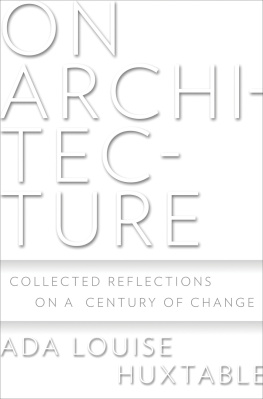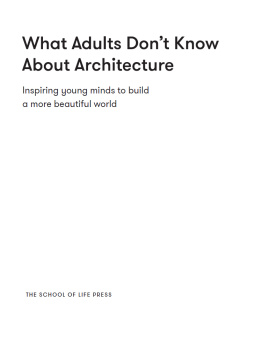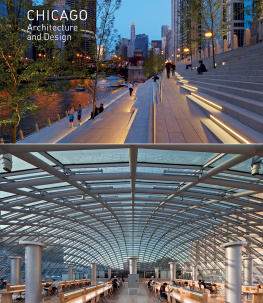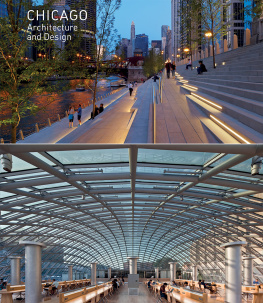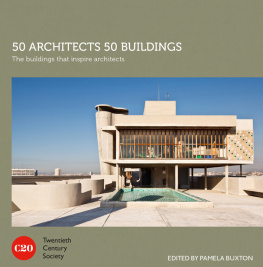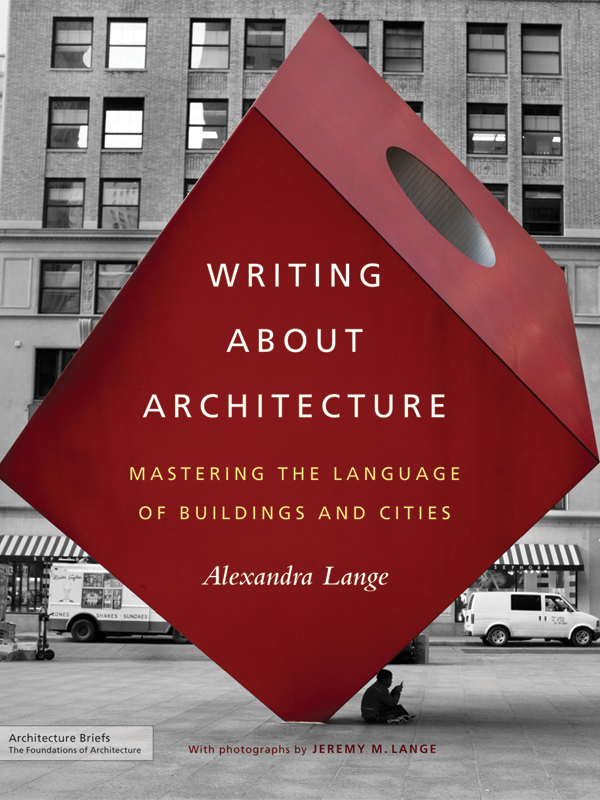

WRITING ABOUT ARCHITECTURE
Architecture Briefs is a Princeton Architectural Press series that addresses a variety of single topics of interest to architecture students and professionals. Field-specific and technical information, ranging from hand-drawn to digital methods, are presented in a user-friendly manner alongside basics of architectural thought, design, and construction. The series familiarizes readers with the concepts and skills necessary to successfully translate ideas into built form.
ALSO IN THE ARCHITECTURE BRIEF SERIES:
ARCHITECTS DRAW
SUE FERGUSON GUSSOW
ISBN 978-1-56898-740-8
ARCHITECTURAL LIGHTING:
DESIGNING WITH LIGHT AND SPACE
HERVE DESCOTTES, CECILIA E. RAMOS
ISBN 978-1-56898-938-9
ARCHITECTURAL PHOTOGRAPHY THE DIGITAL WAY
GERRY KOPELOW
ISBN 978-1-56898-697-5
BUILDING ENVELOPES: AN INTEGRATED APPROACH
JENNY LOVELL
ISBN 978-1-56898-818-4
DIGITAL FABRICATIONS: ARCHITECTURAL AND MATERIAL TECHNIQUES
LISA IWAMOTO
ISBN 978-1-56898-790-3
ETHICS FOR ARCHITECTS: 50 DILEMMAS
OF PROFESSIONAL PRACTICE
THOMAS FISHER
ISBN 978-1-56898-946-4
MATERIAL STRATEGIES: INNOVATIVE APPLICATIONS IN ARCHITECTURE
BLAINE BROWNELL
ISBN 978-1-56898-986-0
MODEL MAKING
MEGAN WERNER
ISBN 978-1-56898-870-2
OLD BUILDING, NEW DESIGN: ARCHITECTURAL
TRANSFORMATIONS
CHARLES BLOSZIES
ISBN 978-1-61689-035-3
PHILOSOPHY FOR ARCHITECTS
BRANKO MITROVIC
ISBN 978-1-56898-994-5
WRITING
ABOUT
ARCHITECTURE
MASTERING THE LANGUAGE OF BUILDINGS AND CITIES
Alexandra Lange
With photographs by Jeremy M. Lange
PRINCETON ARCHITECTURAL PRESS, NEW YORK
PUBLISHED BY
PRINCETON ARCHITECTURAL PRESS
37 EAST SEVENTH STREET
NEW YORK, NEW YORK 10003
FOR A FREE CATALOG OF BOOKS, CALL 1-800-722-6657. VISIT OUR WEBSITE AT WWW.PAPRESS.COM.
2012 ALEXANDRA LANGE
ALL RIGHTS RESERVED
15 14 13 12 4 3 2 1 FIRST EDITION
NO PART OF THIS BOOK MAY BE USED OR REPRODUCED IN ANY MANNER WITHOUT WRITTEN PERMISSION FROM THE PUBLISHER, EXCEPT IN THE CONTEXT OF REVIEWS.
EVERY REASONABLE ATTEMPT HAS BEEN MADE TO IDENTIFY OWNERS OF COPYRIGHT. ERRORS OR OMISSIONS WILL BE CORRECTED IN SUBSEQUENT EDITIONS.
ALL IMAGES JEREMY M. LANGE
EXCEPT PAGE 44 FREESTOCKPHOTOS.ES.
PAGES 2128. HOUSE OF GLASS REPRINTED BY PERMISSION OF THE GINA MACCOBY LITERARY AGENCY. COPYRIGHT 1952 BY ELIZABETH M. MORSS AND JAMES G. MORSS. THIS ESSAY WAS FIRST PUBLISHED IN THE NEW YORKER .
PAGES 14758. FROM THE DEATH AND LIFE OF GREAT AMERICAN CITIES BY JANE JACOBS, COPYRIGHT 1961, 1989 BY JANE JACOBS. USED BY PERMISSION OF RANDOM HOUSE, INC.
EDITOR: LINDA LEE
DESIGNER PRINT EDITION: DEB WOOD
SPECIAL THANKS TO: BREE ANNE APPERLEY, SARA BADER, NICK BEATTY, NICOLA BEDNAREK BROWER, JANET BEHNING, FANNIE BUSHIN, MEGAN CAREY, CARINA CHA, RUSSELL FERNANDEZ, JAN HAUX, DIANE LEVINSON, JENNIFER LIPPERT, GINA MORROW, JOHN MYERS, KATHARINE MYERS, MARGARET ROGALSKI, DAN SIMON, ANDREW STEPANIAN, PAUL WAGNER, AND JOSEPH WESTON OF PRINCETON ARCHITECTURAL PRESS KEVIN C. LIPPERT, PUBLISHER
LIBRARY OF CONGRESS CATALOGING-IN-PUBLICATION DATA
LANGE, ALEXANDRA.
WRITING ABOUT ARCHITECTURE: MASTERING THE LANGUAGE OF BUILDINGS AND CITIES / ALEXANDRA LANGE ; WITH PHOTOGRAPHS BY JEREMY M. LANGE. 1ST ED.
P. CM. (ARCHITECTURE BRIEF SERIES)
ISBN 978-1-61689-053-7 (PBK. : ALK. PAPER)
ISBN 978-1-61689-113-8 (DIGITAL)
1. ARCHITECTURAL CRITICISM. I. LANGE, JEREMY M. II. TITLE. III. TITLE: MASTERING THE LANGUAGE OF BUILDINGS AND CITIES.
NA2599.5.L36 2012
720.1DC23
2011032750


INTRODUCTION
How to Be an
Architecture
Critic
BUILDINGS ARE EVERYWHERE, large and small, ugly and beautiful, ambitious and dumb. We walk among them and live inside them but are largely passive dwellers in cities of towers, houses, open spaces, and shops we had no hand in creating. But we are their best audience. Owners, clients, and residents come and go, but architecture lives on, acting a role in the life of the city and its citizens long after the original players are gone. Architecture critics can praise and pick on new designs, but their readership has lately been too limited. We talk (in person, on blogs) about homes as investments, building sites as opportunities, unsold condominiums as an economic disaster, but all of that real-estate chatter sidesteps the physical reality of projects built and unbuilt. Rather than just talking about money, we should also be talking about height and bulk, style and sustainability, openness of architecture and of process. Design is not the icing on the cake but what makes architecture out of buildings and the places we want to live and eat and shop rather than avoid. Instead of less talk, what we need are more criticscitizen criticsequipped with the desire and the vocabulary to remake the city.
There are times when city dwellers have been roused from passivity. Disaster (Ground Zero) and personal affront (NIMBYism) make protestors out of us all, but we are rarely roused by the day-to-day, brick-by-brick additions that have the most power to change our environment. We know what we already like but not how to describe it, or how to change it, or how to change our minds. We need to learn how to read a building, an urban plan, and a developers rendering, and to see where critique might make a difference.
This is a handbook that demonstrates how critics look at those buildings, parks, and plans, and shows how anyone can follow in the footsteps of those writers. It is based on courses in architecture criticism I teach at New York University and the School of Visual Artsclasses that simultaneously offer a foundational history of twentieth-century criticism and lessons in doing it yourself.
In the courses and in this book, I connect the reader and the writer, the citizen and the critic, in two ways. First and foremost by reading and comparing exemplary pieces of critical writing. Each chapter in this book is preceded by a complete essay or lengthy excerpt from a piece of critical writing about a different building or urban type: Lewis Mumford on skyscrapers, Herbert Muschamp on museums, Michael Sorkin on preservation, Charles W. Moore on the monument, Frederick Law Olmsted on parks, Jane Jacobs on cities. In the text that follows the essay, there is a close reading of that essay, discussing the specific questions raised by the critic about the type and the methods he or she uses to raise those questions.
There is no one right way to write architecture criticism, but the critics discussed in this book all get it right in different ways. An understanding of their style, editorial judgment, and mode of argument can help future critics to get it right as well. Digging into Olmsteds principles of park design, for example, one gains a sense of the history the landscape architect is working against or within. Reading Karrie Jacobss review of the far more recent High Line, one sees those principles considered and rejected in the contemporary park. There is continuity between Central Park and the High Line, but it takes a deeper knowledge of American park design to see it.



